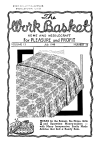FUNDRAISING
OUR FUNDRAISING CAMPAIGN HAS STARTED! GOAL: 5000 USD / 6125 CAD AND CURRENTLY AT 25%
To keep our Library up and running, we hold a fundraising campaign from September to December.
If you can’t afford to donate, but would like to help the Antique Pattern Library, introducing the Library to people who don’t know of it yet, is very useful, since it broadens our user base and therefore also our future donor base. Blogs, Tiktok, Instagram, Pinterest, Ravelry, Facebook, other social media – show others your favorite publications and what you made using them. Our work is only useful when people actually use it!
If that is not possible either, just enjoy our new publications either for inspiration or for your own work! This new Workbasket will show you more examples – as if we didn’t have enough projects already 🙂
NEW PUBLICATION

I-WB13A The Workbasket Volume 13 July 1948 Number 10
Stapled softcover, 24 pages. Crochet: Day Lily square motif for tablecloth or bedspread, burlap rugs, metallic slippers, sugar bowl and creamer motifs, luncheon set in crocheted cut-work, medallion doily, tea cart cloth square crocheted motif to sew to linen squares in chessboard pattern, pan holder, Petal Wheel hot pad, crocheted square blocks for afghan. Tatting: tatted handkerchief edges. Metalcraft. Knitting: Double Cable Stitch. Aunt Ellen’s Club Notes.
From the collection of Sarah Dalton, scanned by Seya Wijnsma-Spek, edited by Sytske Wijnsma. Published with kind permission of F+W Media, the current copyright holder.
Most of the crochet items are small pieces that can be joined to make larger items. That gives the flexibility to use them for more purposes than here described. The burlap rugs as described require a burlap sack to unravel, as those times people had less resources and had to make do with whatever was avalable, especially for free. It’d be less work nowadays just to buy the yarn separately. This new workbasket gives an insight in how our parents or grandparents lived and makes us count our current blessings, and gives us hints how to use fewer resources for the same result.